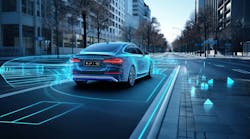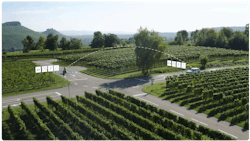What you’ll learn:
- How V2X technology can save lives.
- The various ways V2X can help reduce cost.
Vehicle-to-everything (V2X) communication enables vehicles and other road users to communicate with one another and their environment.
The technology complements the information coming from other sensors, specifically in non-line-of-sight scenarios, rough weather, or poor lighting conditions. It significantly improves overall road safety, effectively coordinating vehicles, self-driving cars, motorcyclists, cyclists, and pedestrians.
In 2016, the NHTSA published an analysis on the safety potential of vehicle-to-everything comms while proposing to mandate V2X in all new passenger cars. The proposal was recently withdrawn, but its insights still serve as a solid reference. It showed that V2X would save an estimated 987 to 1,366 lives and 305,000 to 418,000 injuries per year.
While these numbers are impressive and rarely achievable with other new safety features, people familiar with the potential of V2X must be puzzled as to why the estimated value was so low. The main reason is that only two intersection warnings were analyzed: Intersection Movement Assist (IMA) and Left Turn Assist (LTA) between two vehicles.
How V2X Can Save Lives: A Look at the Numbers
Therefore, the analysis scope should be extended to all potential accidents among all road users that are preventable with V2X. NHTSA’s Fatality Analysis Reporting System (FARS) database contains detailed information about accidents until 2021. Tragically, an analysis using 2022 data will yield a higher V2X value following the drastic rise in the number of fatalities, reaching over 42,000. As a further comparison, the 2016 report assumed ~33,000 fatalities, which was the average in 2010-2013.
Several things need to be changed in the analysis to estimate the full V2X life-saving potential. First, the protection of two-wheelers, namely motorcycles, eBikes, eScooters, and bicycles should be included. V2X can detect two-wheelers even when the visibility is limited, specifically around corners.
When examining two-wheeler fatalities, after excluding self-motorcycle accidents, nearly 30% of bicycle fatalities happen at intersections. A similar ratio of motorcycle fatalities also happens when the motorcycle is hit from the side or back. V2X is very effective in preventing such accidents.
V2X remains effective, albeit a bit less, in averting all other two-wheeler accidents, typically resulting from the difficulty of identifying a two-wheeler. In total, V2X can save 1,671 motorcyclists and 351 cyclists lives, as well as reduce the injuries of 22,322 motorcyclists and 19,892 pedalcyclists.
Second, the protection of pedestrians using V2X isn’t science fiction anymore. Soon enough, technological progress will bring V2X to all smartphones. But before that, smart infrastructure will be deployed with sensors, like cameras or LiDAR, to detect road users without V2X. Drivers will become aware of pedestrians at intersections, which is where 15% of pedestrian fatalities occur.
In addition, cooperative perception, where a vehicle shares the objects detected by its vehicular sensors, will add pedestrians to the V2X network everywhere—not just at intersections. Most pedestrian fatalities are typically at night on fast urban roads, where a driver doesn’t expect a pedestrian. Lighting conditions don’t impact V2X, which can alert drivers from afar about the presence of pedestrians. Overall, 1,984 lives can be saved, and 17,943 injuries can be reduced.
Third, V2X can effectively address all multi-vehicle accidents and not just those at intersections, where only 25% of fatalities occur. V2X provides early indication for road events ahead, such as slowdowns or stopped vehicles, and can effectively alert before a dangerous passing is initiated. Moreover, dangerous lane changes are detected even when the vehicle coming from behind is obstructed.
The inclusion of trucks and buses in the V2X network is crucial, given their disproportionate involvement in fatal accidents. Of the 13,780 fatalities in multi-vehicle accidents, 5,646 lives can be saved, and 834,126 injuries can be mitigated.
V2X Safety Measures Including Automatic Braking
The 2016 report defines V2X effectiveness as the ability to prevent an accident. A 2010 study measured that a driver could prevent, on average, 50% of accidents following V2X alerts. Back then, safety sensors were only capable of issuing warnings to drivers. A decade and a half later, modern vehicles brake automatically to avoid road dangers.
V2X will follow a similar path and implement automatic braking to increase effectiveness and enhance the driving experience. The likelihood of preventing a forward collision is 66% higher with automatic braking compared to relying solely on an alert. With V2X, the efficiency increase is probably higher, since V2X alerts are issued when the driver cannot see the approaching risk, potentially leading to failure to act. This analysis assumed a conservative efficiency increase of 50% over the 2010 study.
In total, 9,652 lives can be saved, and 894,382 injuries can be reduced.
Saving Lives and Avoiding Injuries Also Saves Cost
The dollar value of a fatality or an injury increased by 15% since 2016. The average cost of a fatality or injury slightly varies depending on the involved road user type. The average fatality cost is $10.6M, while the average cost of an injury, combining medical costs, quality of life loss, and work loss is $250K-$300K for an injury requiring hospitalization and $80K-$95K for an injury requiring a doctor visit. The overall societal cost for fatalities is $101B, and for injured it’s $53B.
That doesn’t include property damage and congestion. Therefore, based on a 2016 analysis, an additional 16% should be added, which amounts to $178B.
Savings will be fully achieved when all vehicles have V2X. Taking into consideration the first generation of V2X applications, called Day1, adding V2X to all vehicles on roads will take decades. Collective perception, introduced in Day2 (second-generation V2X applications), adds non-connected vehicles to the V2X network.
With only 3% of vehicles on the road having Day2 V2X, nearly half of all vehicles become part of the V2X network. Jump that to 10%, and nearly all vehicles join the V2X network. Thus, the maximum potential of V2X can be realized in just a few years. With a value this immense, the push for V2X should start now.

